I haven’t baked any bread in a long time, mostly because I don’t eat bread very often lately. I do love to bake, though, so when I came across this recipe for No Knead English Muffin Bread on KitchenParade.com, I knew I had to make it, even if just for fun. If you’re a bread person and eat it often, making your own bread can be a huge money saver. An artisan loaf at the store will run you between $3-$4, but you can make it at home for less than a dollar. If you’re intimidated by baking bread, a “no knead” recipe like this is perfect to get you started and a little more comfortable with the bread making process.
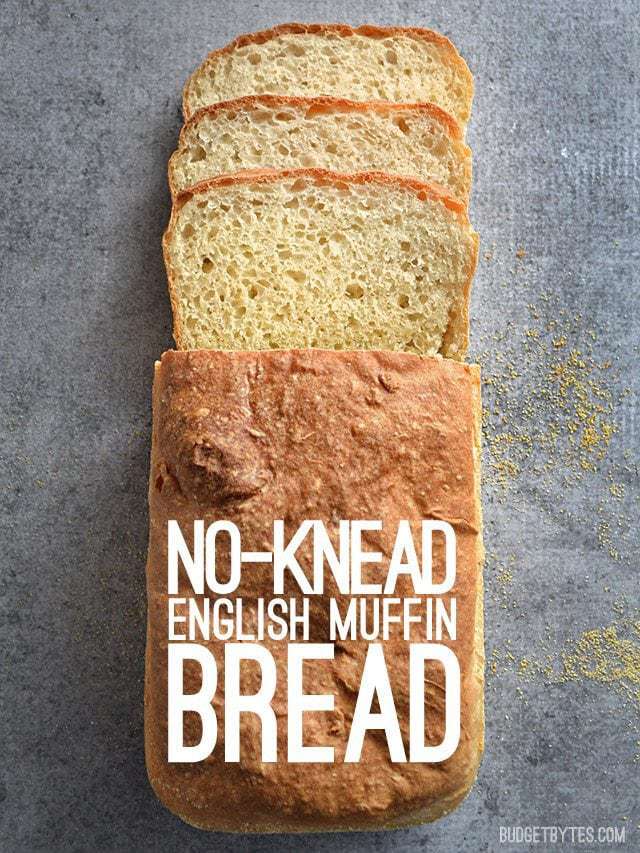
This post contains some affiliate links, which means that we make a small commission off items you purchase at no additional cost to you.
What makes this bread “English Muffin” bread? I dunno, just the heavy coating of cornmeal and delicate crumb, I guess. To me English Muffins are a bit more “eggy”, but this bread is still great all the same. So, we’ll just call it English Muffin bread for fun, deal?
Want to try making regular English Muffins? Check out my Homemade English Muffins recipe!
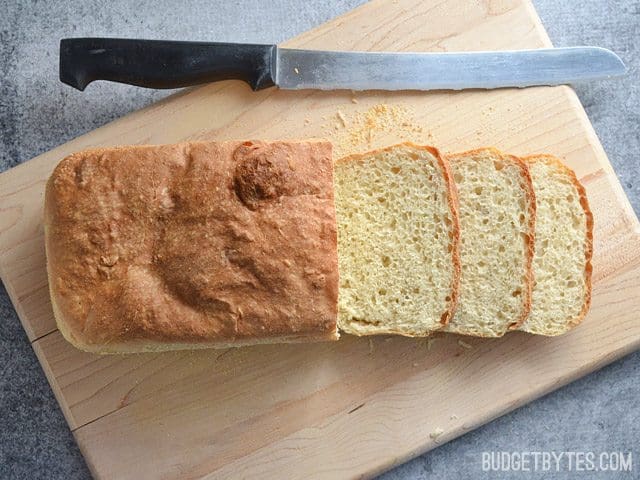
No Knead English Muffin Bread
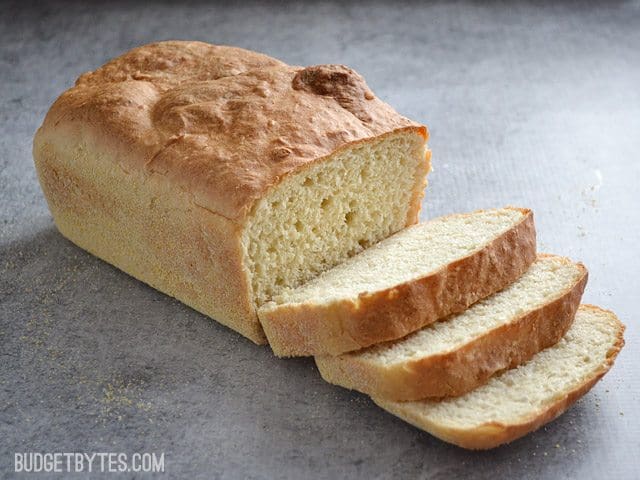
Ingredients
- 2 1/4 cups flour (plus some for dusting) ($0.38)
- 2 tsp (or one 1/4 oz. packet) instant yeast ($0.19)
- 1 Tbsp sugar ($0.03)
- 3/4 tsp salt ($0.03)
- 1 cup warm water ($0.00)
- 2 Tbsp cornmeal ($0.08)
Instructions
- In a large bowl, combine 1 cup of the flour with the yeast, sugar, and salt. Add one cup of warm water and mix with a hand mixer on medium speed for three minutes. Use a timer to make sure it is mixed for a full three minutes.
- Begin to add the remaining 1 1/4 cups of flour, a small amount at a time, until you can no longer use the mixer. At that point, use a large wooden spoon to stir the rest of the flour into the dough. The amount of flour needed may be slightly more or less depending on the moisture content of your flour, but you should aim for a very soft, pliable, slightly sticky dough in the end.
- Coat a loaf pan with non-stick spray, then dust the inside heavily with cornmeal (about 2 Tbsp). Sprinkle a little extra flour onto the dough to keep it from sticking to your hands and mold it into a rough loaf shape. Place the loaf in the pan, cover with a damp paper towel, and let rise for one hour, or until the loaf has risen higher than the top of the loaf pan.
- Preheat the oven to 400 degrees. Bake the risen loaf for 30-45 minutes, or until it sounds hollow when tapped. If the top begins to brown too much before 30 minutes, cover with foil to reduce further browning (I covered mine after 20 minutes).
- Remove the loaf from the pan and let it cool completely before slicing.
See how we calculate recipe costs here.
Nutrition
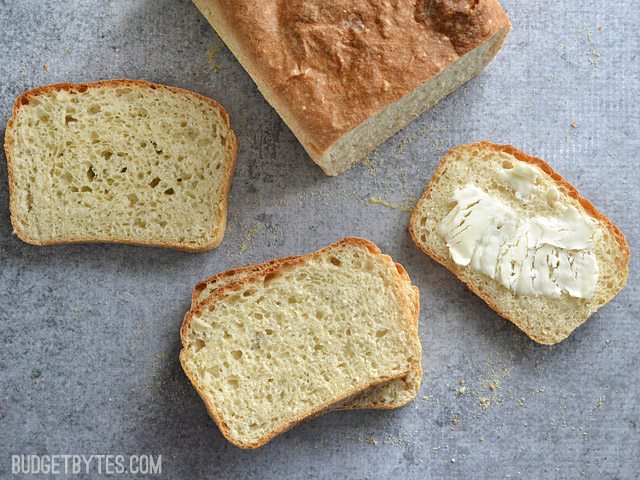
How to Make No Knead English Muffin Bread – Step by Step Photos
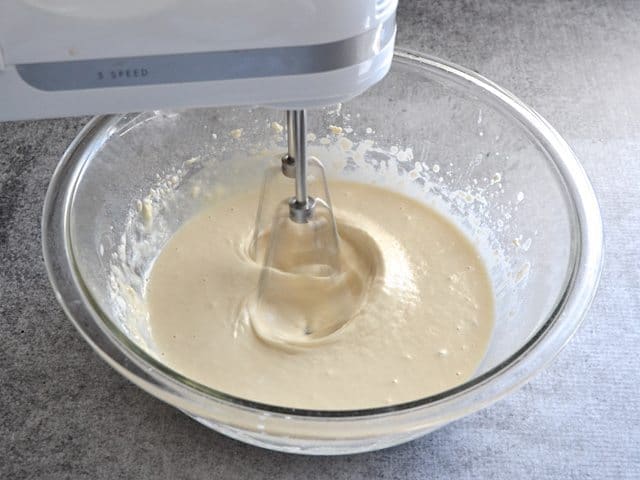
Start by combining 1 cup of flour, 2 tsp instant yeast (or one 1/4 oz. packet), 1 Tbsp sugar, 3/4 tsp salt, and one cup of warm water in a large bowl. Mix the ingredients using a hand mixer set on medium speed for three full minutes. A word to the wise, start the mixer on low then increase to medium once it starts to come together, so you don’t spray flour all over your kitchen. ;) This mixing action partially develops the gluten, which is a substitute for the kneading process.
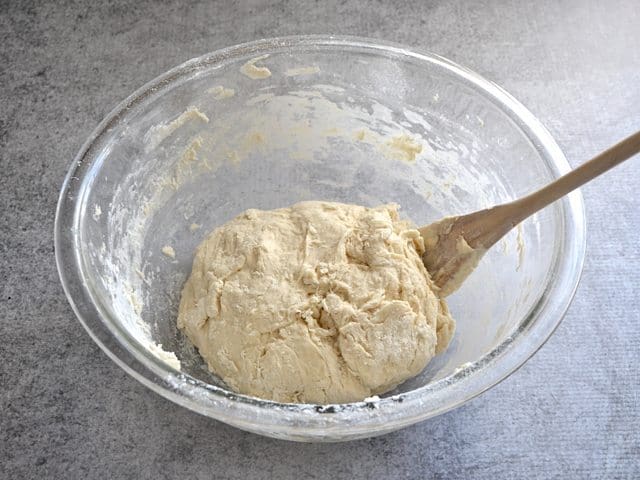
After mixing for three minutes, begin to add the remaining 1 1/4 cups flour, a little at a time. Once it becomes too thick to use the mixer, use a large wooden spoon to stir in the rest. The total amount of flour you need may be slightly more or less, depending on the moisture content of the flour. The end result should be a soft, pliable, slightly sticky dough (no piles of dry flour on the bottom of the bowl).
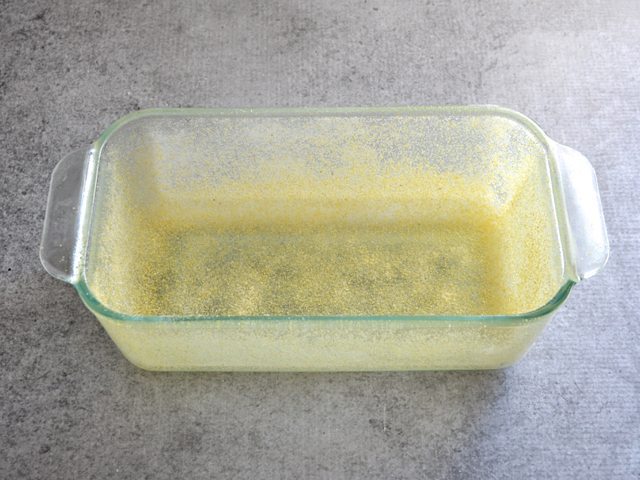
Prepare a loaf pan by coating it with non-stick spray, then using about 2 Tbsp of cornmeal to dust the inside. This creates a nice thick crust of crunchy cornmeal on the outside of the bread—just like an English Muffin!
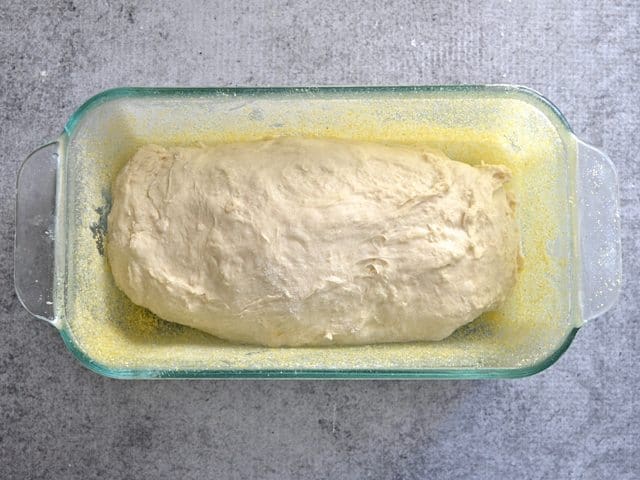
Sprinkle a little flour on the dough and your hands to keep it from sticking, then shape it into a rough loaf. It doesn’t have to be perfect. If you *want* to knead it a couple times, it will make the dough a bit more even and pretty, but it’s not necessary. Place the loaf in the prepared pan.
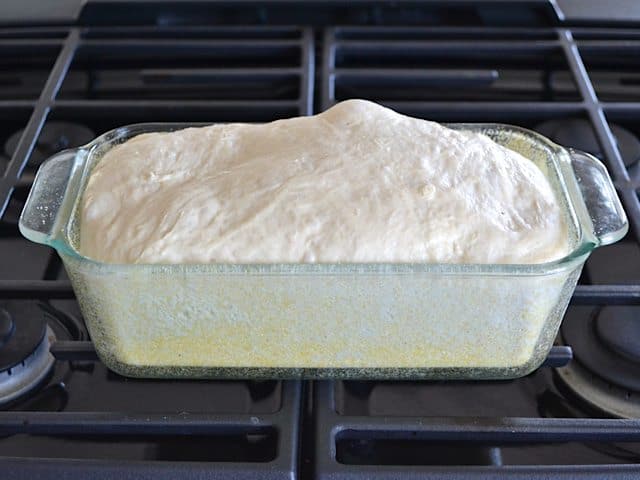
Cover the loaf pan with a damp paper towel and let it rise for one hour or until it rises up out of the top of the loaf pan. I let mine go for about 1 hour and 15 minutes because it was a tad chilly in my house. Again, the lumpy shape of the top can be eliminated by working the dough just a bit before shaping it into a loaf.
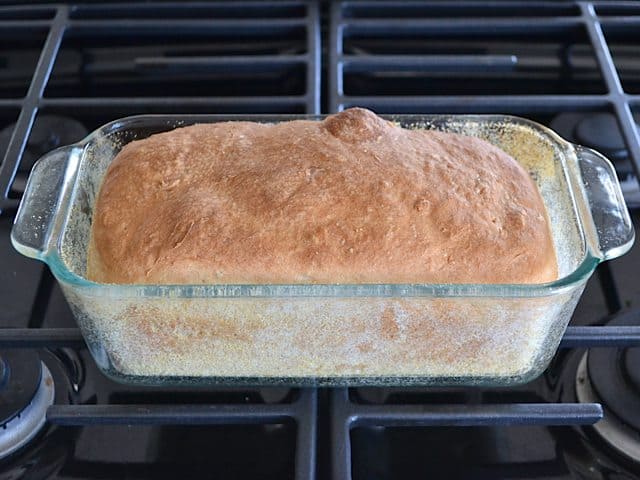
Preheat the oven to 400 degrees, then bake the English muffin bread for 30-45 minutes, or until it’s golden brown and sounds hollow when you tap the crust. If the top begins to brown too fast (it needs to be in the oven for at least 30 minutes), you can cover it with foil to slow the browning process. I ended up adding foil at about the 20-minute mark and baked for 30 minutes total.
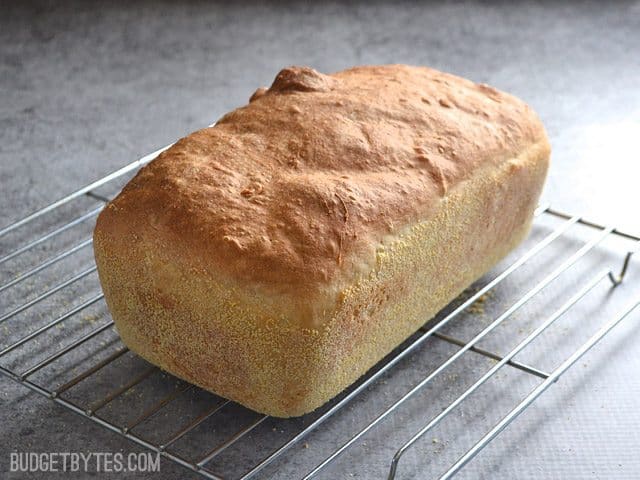
Letting the loaf cool completely before slicing it is one of the hardest things to do, but one of the most important. The english muffin bread is soft and squishy when warm and trying to slice it in that state will tear it apart or flatten it completely. Neither is good. So, let that bread cool!
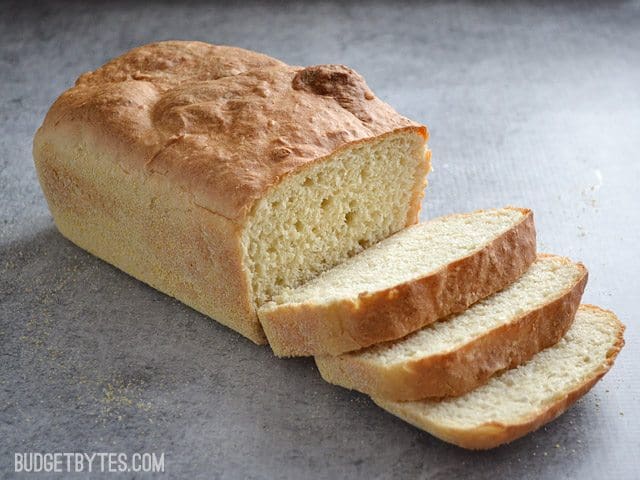
Once it’s cool, slice it, toast it, and slather it up with some butter and jam!
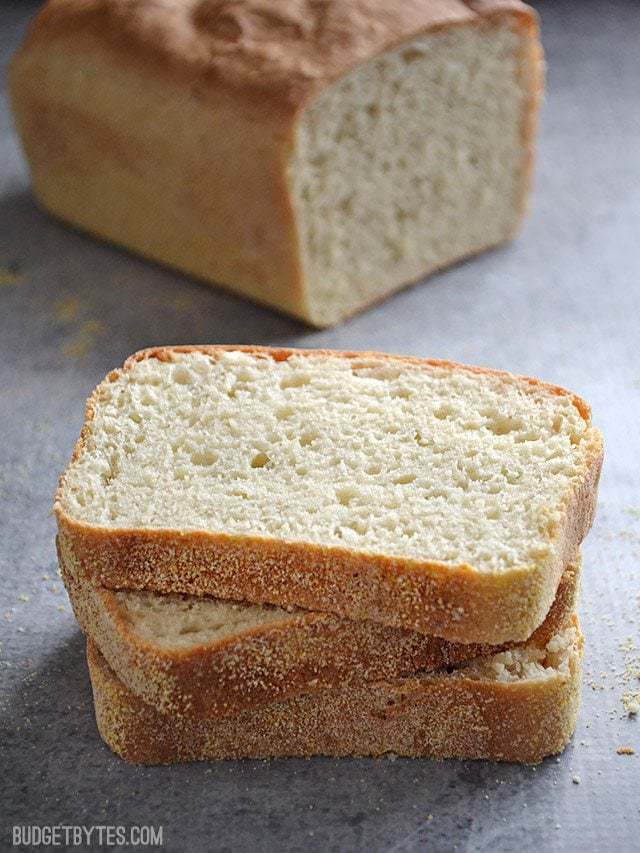
Homemade bread with no fancy machines and no fancy skills needed!


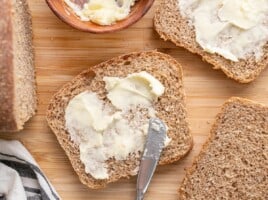
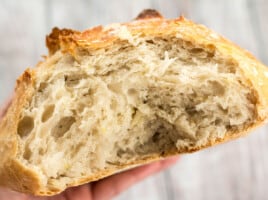
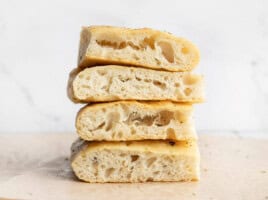
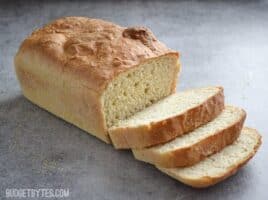
I assume this will work just as well without the mixer, right?
Yes, but you’ll be doing a LOT of hand mixing and the mixture is quite thick. Be prepared for sore muscles the next day. ;) The mixing part is pretty important because it helps develop some gluten in the place of kneading.
This recipe is great! It turned out beautifully.
Looks delicious! How would the cooking times/temperatures change if you were using a nonstick loaf pan?
It shouldn’t be too much different. It may brown a little faster on the parts that are touching the nonstick pan, but not enough to worry about. I’d have to experiment to say for sure. I think your best bet is to keep an eye on it in the oven and put foil over top if it browns a lot before 30 minutes.
Love this post, and everything you share really. I’ve been tightening my family’s grocery budget, and making my own bread is the next logical step, I am just so nervous about working with yeast!
I’ve made this twice now and mine won’t rise. Followed the recipe exactly, wonder what I’m doing wrong. Taste good though.
Are you using “instant” or “bread machine” yeast? “Rapid Rise” yeast is different and usually needs to be dissolved into warm water before adding to a recipe. I’ve had others say that they’ve used rapid rise and it worked okay, but it probably won’t work as consistently as instant or bread machine yeast.
So every time I see a bread recipe, I quick look it over and then realize I hate working with dough and the alternative no-knead recipes make me wait so long… until I saw this. Thank you so much for this post (and your blog in general). I just made an amazing bread that I’m proud of, and took maybe 10 minutes of my time (counting making it and checking the oven after it was in). I’m force-feeding my roommates to make sure they know I can bake now. Thanks Beth!
It’s nice to add a softer, lighter loaf to my no-knead bread arsenal. This one makes great toast, and goes especially well with jam or apple butter. (Slow-cooker apple butter is an excellent way to use up bruised or overripe apples, by the way.)
I ran into some trouble during the rising phase, though. The damp paper towel got stuck to the dough as it rose above the loaf pan and I had to mutilate the dough a bit to get it off. Any suggestions?
You can try just removing the towel when the dough gets big enough to touch it draped over top, or maybe try coating the dough in oil before it goes in the pan. That should help keep it moist, too.
Usually oil is needed for yeast bread, why isn’t oil used in this recipe? Wanting to make it right away I did add 2 Tbsp.olive oil to the recipe. Very good!
Many yeast bread recipes don’t use any sort of oil or fat. When it is used, it is usually added to make a softer crumb. It acts by slightly inhibiting the formation of the gluten matrix, keeping it soft rather than elastic (think of the texture of cake vs. the texture of a stiff French bread). Since the gluten is only partially developed for this recipe, it stays soft even without any added fat. :)
Thank you, I’ll try it.
Love this bread! Tried it for the first time yesterday, easy and yummy!!! Especially good toasted. We are trying not to buy any bread this week. Second and third loaves are rising! Thanks Beth!
I am an awful baker and I’ve always stayed away from making breads because they seem complicated. However, this was SO easy to make and it tastes great! :) Thanks for such an easy recipe.
My first time making bread! Thank you for presenting us with a recipe that’s delicious and not intimidating for us beginners. This recipe turned out great, and motivates me to continue experimenting with breads!
Will Gluten-Free bread flour work?
BTW…I made your Marinated Kale, White Bean and Tomato Salad this morning. Also, made the Seasoned Jasmine Rice. Wow! Great! Serving both with baked ham early this afternoon.
Unfortunately, I’ve never baked with gluten free bread flour, so I’m not sure. :(
Hey Shirley!
Gluten-free flour will most likely not work. Bread needs gluten for structure, especially something like this that’s going to have little holes throughout. GF flour can work well in things like cake and cookies where you don’t want it to be chewy. When you want something to be chewy, like a baguette vs pancakes, gluten needs to be invited to the party. Sorry.
-meg
The book Gluten Free Girl has a gluten free chewy bread recipe that sounds great, by the way. When we were GF, we just used Udi’s bread because GF bread is tricky and I can’t bake well with regular flour (though I’m definitely trying this recipe!) But GF bread can be done with the right tools and skills. We used to get some great fresh baked bread at a GF bakery in town. Several GF baking books are out there too, usually involving a combination of flours and xantham gum. There are also GF bread mixes out now that you can use in your bread maker (assuming it’s not cross contaminated with gluten flours.) The bread mixes aren’t exactly the same as what you may be used to, but are quite good toasted and with jam. I know this post is older, but I wanted to mention these things in case other newly GF people ever come across the recipe and wonder. But yes, Meg is totally right in that gluten adds the stretch and chew– directly replacing the flour in this recipe won’t work unless you use one like Better Batter that had xantham gum already added and has various flours in it. King Arthur has a similar 1:1 ratio kind of mix, ifI recall right. Actual GF bread recipes take into account the lack of gluten and work around it in various ways, some with better results than others. Good luck!
That bread looks be-YU-ti-ful!
I am a no knead fanatic. Up until 4 years ago, I made bread “kneaded” and never got the flavor/texture/crust that I now get from no knead. As you said, the cost savings is incredible also. And with the no knead method, almost everyone can fit it into their schedule. I highly recommend “Artisan Bread in 5 minutes per Day” for any who want to start and want other recipes. Lots of free info on their website but the book is worth the price in my opinion for reference and trouble shooting as you start.
After the bread is cool, I typically slice and freeze about 1/2 with the slices separated by parchment. It is easy to get a slice or 2 out. To store artisan breads without freezing, place cut side down on a cutting board and cover with a cloth. I find it is good for 3 days. Funny as bakery artisan breads seem only good the first day ???
Hi Beth, do you think white whole wheat flour ir whole wheat pastry flour would work? I really need to make this! Thank you ♡
I haven’t tried it, but the original recipe poster left a comment here noting that she uses half whole wheat flour with great results! :)
Traditional breads (the ones that only use yeast as leaveners) all heavily rely on gluten to give them structure and to trap the gases that the yeast produces. For these breads, it is important to pick a bread with high protein content, as that’s a measure of the amount of gluten.
Pastry flours are low in gluten, as the goal is to make soft spongy cakes, rather than more “gummy” breads. All-purposes flours have varying amounts of protein — with King Arthur Flour being noteworthy for the exceptionally high protein content. And bread flours have generally high amounts of gluten.
Whole wheat flours usually have high amounts of protein as well, and thus generally should be OK to use in place of all-purpose or bread flours. But the extra fibers are hard and can damage the structure of the dough. So, when using whole wheat instead of white flours, start your experiments by substituting only part of the flour. Also, change the order how you make the recipe, and start by mixing the water and whole wheat flour at the very beginning of the recipe. Then let sit for a while, maybe even overnight. Soaking the whole wheat allows the fibers to soften.
Having said all of the above, the recipe on this page looks as if it makes a somewhat wetter dough, although not quite a batter. As such, it won’t be quite as susceptible to problems with the fibers in whole wheat. So, you are probably fine.
I have seen other recipes add baking powder in addition to yeast, in order to make up for limitations in the gluten. But that’s decidedly going to result in a different texture. So, I wouldn’t go there, unless you find that nothing else helps.
Using a white whole wheat is a great choice. It handles the same as red whole wheat, and it has the same nutrients. But it is made from a variety of wheat that doesn’t have as much bitter flavors. I personally prefer it a lot over the more common red whole wheat. It has a nice and complex nutty flavor, but it doesn’t overwhelm the entire dish; it’s more subtle.
I don’t have an electric mixer would you recommend mixing this bread in a way similar to your recipe for oatmeal molasses bread?
Yes, but it might not work quite as well. All that mixing helps develop some of the gluten and takes the place of some of the normal kneading done in a bread recipe. That being said, I’ve made no knead bread recipes that don’t use a mixer to beat the gluten into submission, and they were still quite good.